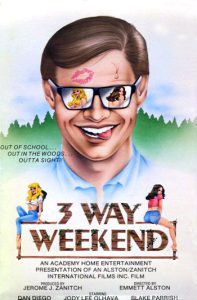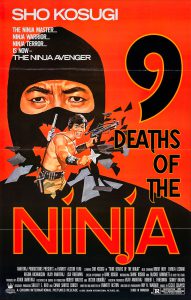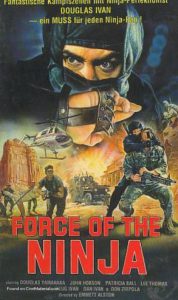The Vault of Horror (1973) by #RoyWardBaker
w/ #GlynisJohns #CurdJürgens #TomBaker #DawnAddams
Locked in a vault, five men swap stories of recurring nightmares.
"Below the Crypt lies Death's waiting-room"#Horror #Anthology#NotQuiteClassicCinema pic.twitter.com/wwy1aebZF5
— Angus Kohm (@AngusKohm) July 10, 2021
As I may have mentioned a while back, I was a big fan of Tales from the Crypt (1972) when I was a kid. I watched it several times over the years, and each time it just got better and better. The Vault of Horror (1973) was the direct sequel to Tales from the Crypt, but somehow I didn’t see it until I was well into adulthood. And, unfortunately, when I did finally watch it, it turned out to be the censored TV print. I didn’t know this until afterwards, but the whole time I was watching The Vault of Horror, I couldn’t help but feel that something was missing. It just didn’t have the same spark that Tales from the Crypt had – which was odd, because it was a decently rated film (2.5 stars in Terror On Tape – and some of my favourite movies rated 2.5 stars in that book). Once I figured out that there was actually missing footage in the version I watched, I knew that I had to track down the uncut print…
![The new Tales From The Crypt / Vault Of Horror [Double Feature] - Blu-ray from Scream Factory](http://certified.anguskohm.com/wp-content/uploads/2021/07/CryptVaultBRCover300dpi-239x300.png) And thanks to Shout Factory (or Scream Factory) releasing a double feature Blu-ray of both films, I finally did.
And thanks to Shout Factory (or Scream Factory) releasing a double feature Blu-ray of both films, I finally did.
It turns out that there is only about 40 seconds of extra footage in the uncut print, which doesn’t seem like a whole lot, but depending on what it is, it could make a big difference to the viewing experience. And, of course, I wondered if perhaps there might be alternate footage in some moments. I recall the unrated VHS tape of Re-Animator (1985) being shorter than the censored R-rated edition. According to the IMDb, this is due to the addition of “16 non-violent scenes.” I just remember L.A. Morse, in his book Video Trash and Treasures, imploring everyone to rent the shorter version (which didn’t seem like the obvious choice, but he was right).
I should mention that The Vault of Horror was directed by Roy Ward Baker, who directed a lot of movies and television – including classics like The Vampire Lovers (1970), Scars of Dracula (1970), Dr Jekyll & Sister Hyde (1971), Asylum 1972) and one of my other childhood favourites, The Monster Club (1981). Those last two were anthologies, like The Vault of Horror. The Monster Club is not as well loved as the other films I mentioned, but I rented it on Beta when it was pretty new and I loved it. It was one of those movie that I watched about three times before returning the tape to the store the next day. As a result, the nostalgia level is through the roof whenever I look at it now. I suppose it’s impossible for me to accurately assess it as a piece of filmmaking, but who cares? That’s why the word favourite exists. It has nothing to do with overall filmmaking excellence or critical judgment.
The Vault of Horror is not coloured by any such feelings in my case. I was over 30 the first time I saw it, and it wasn’t exactly a steller viewing experience. It did make me want to see the uncut version, but I didn’t feel any particular love for the movie. Basically, I was withholding my judgment until I could see it as Roy Ward Baker had intended me to – and last week I finally got the chance.
I already knew this from the first time, but the cast is truly outstanding. From Anna and Daniel Massey to Terry-Thomas and Glynis Johns to Curd Jürgens and Dawn Addams to Denholm Elliott and Tom “Doctor Who” Baker – the list goes on and on. The production values are excellent, and the film feels very much like an Amicus Production (which is a good thing). The stories are a bit of a mixed bag, which is often the case in anthologies. I like two of them very much, and I must say that the one with Denholm Elliott and Tom Baker is my favourite. The other stories are more cute and funny, as opposed to scary, but that’s not a bad thing either. Basically, it’s a fun movie.
The uncut footage is mostly gore, and it does add something to the overall experience. It does not, however, elevate mediocre stories to excellence. For my money, The Vault of Horror is not as good a movie as Tales from the Crypt – but keep in mind that my feelings of nostalgia are working overtime for that movie as well. I have no doubt that The Vault of Horror is a better movie than The Monster Club, but I will likely never feel as warmly toward it because of nostalgia (or lack thereof).
Don’t get me wrong, I enjoyed this sequel very much and would say that The Vault of Horror (1973) is a fine example of #NotQuiteClassicCinema. I’m sure that it has nostalgic fans who would treasure it above many other films I have mentioned – and rightly so. There is no wrong when it come to favourite movies. And while I wouldn’t list this one among my own personal favourites, I would definitely watch it again someday – perhaps on another rainy #FridayNightAtTheHomeDriveIn.



